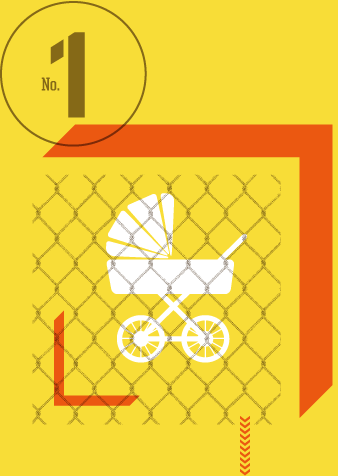Top 10 Risks
Is your church taking a chance in these all-too-common areas?
Childcare and youth volunteers who aren’t adequately screened
Authorities both inside and outside the EFCA agree on this risk’s priority. Notes Bob Johnson, safety and security director at Christ’s Church of the Valley in Peoria, Ariz.: “Ask 100 people from 100 different churches: ‘What’s the No.1 concern in safety and security in your church?’ Every one of them will say, ‘The children come first. Go protect the children.’”
Adds Greg Braly, children’s ministry pastor at New Hope (Minn.) EFC: “Policies and procedures are in place to prevent not only active predators (those actively looking) but also impulsive predators (those who abuse in an unguarded moment). By always having two people in a room (the two-deep rule), neither is given the opportunity.
“As a family/children/youth pastor for the last 26 years, I have never met a predator who looked like a predator.”
For screening ideas, see “Reducing the Risk” and “Creating Child Protection Policies.”

Unclear policies and procedures for pastoral counseling
Policies vary from state to state regarding “clergy-penitent privilege”—the legal term for the right of a pastor to not disclose confidential information in a court proceeding. The lines can be equally fuzzy as to when someone is required to report child abuse. And do your student-ministry volunteers know what to do when a young person confides about abuse or even suicidal thoughts? Don’t take chances with this; ask an attorney.
In addition, church leaders are wise to put accountability procedures in place—such as counseling rooms with a window—for when a man and a woman are in counseling situations alone, advises Russ McCune, business administrator at The Orchard EFC in Arlington Heights, Ill. Insurance providers are a good resource for developing procedures.
Read “Pastoral Confidentiality: An ethical and legal responsibility” in Enrichment Journal, then discuss your specific situation with your attorney.

Lack of dual controls with church funds
Too many churches entrust the checkbook or benevolence fund to only one individual, or ask only one person to count the offering. “A lot of people don’t know when they’re partaking in risky behavior from a financial standpoint,” reports Nancy Smith, EFCA director of accounting. “By insisting on dual controls, you’re not accusing someone of not having integrity; rather, you’re protecting him or her from accusation. For me, those are basics, but in a small ministry, we sometimes take unnecessary risks with the funds people have stewarded us with.”
For extensive help on this topic of dual controls, read Chapter 6 (“Financial Records and Reporting”) in the Zondervan 2011 Church and Nonprofit Tax & Financial Guide, by Dan Busby.

Inadequate release forms for youth ministry or mission trips
“This is a huge issue—release forms are a crazy part of the job that no one tells you about!” exclaims Dan Luebcke, former student ministry pastor and now associate staff at Southern Gables EFC in Littleton, Colo. “You need to consult a lawyer and draft one that can serve as both a liability release and a health information sheet. Ours has three copies: one for the parents, one for the office and one to take on trips. We keep them in a file for the duration of a student’s participation in our ministry. For specific events, we sometimes need to buy a rider, but in most cases, our insurance policy covers us.”
“Last year, our student ministry contacted a safety consultant before taking high-school juniors and seniors to Haiti,” adds Lucas McGarity, middle-school ministry director at First EFC in Wichita, Kan.“The other youth pastor and I had been to Haiti earlier, but we felt we needed an additional point of view regarding safety. Our consultant looked at the information and gave us his professional opinion. Then he looked at all of our student ministry permission/medical forms and waivers, advising us how to make them stronger. In addition, he has helped our church as a whole with security analysis, fire evacuation and building oversight.”
Another recommended resource: Better Safe Than Sued: Keeping your students and ministry alive, by Jack Crabtree. Also, read “Updated Release Forms: Because kids will be kids” about a student-ministry accident on church premises.

Lack of preparation for community-wide crises
Without a well-rehearsed crisis-response plan in place when disaster strikes, a church faces two risks: not being able to adequately care for its own, and having no margin to consider ministry in the surrounding community.
“Preparedness is part of shepherding,” says Mark Lewis, director of EFCA TouchGlobal. “The shepherd checks the fences to ensure they’re safe. He locks the barn door. It’s part of leadership to anticipate the threats to those under your care.
“Preparedness also includes developing vision to see the mission field that follows crisis. A pastor once told me that if his people did not help their community in need, he feared for their spiritual health” (1 John 3:16,17).
Read about the aftermath of crisis for one EFCA church in “Disaster Preparation: Because you likely won’t see it coming.” Contact TouchGlobal for information on its four-hour crisis-recovery training as well as a free survey to assess your church’s preparedness.

Lack of an electronics-use policy
In today’s “connected” world, churches are wide-open to dangerous risk related to the computers and cell phones provided to their staff—everything from texting while driving to accessing inappropriate websites. According to the Evangelical Council for Financial Accountability, churches should establish policies that clearly articulate employer rights to access and inspect such usage. Read about what leaders at one EFCA church uncovered when they implemented computer-tracking software.

Inadequate procedures and equipment for medical emergencies
Medical emergencies can occur anywhere: falls on a church playground or icy parking lot, choking during a fellowship meal, or cardiac arrest during a worship service. Churches should have an extensive first-aid kit and several staff members trained in CPR, especially for infants and children. An automated external defibrillator is also pivotal—often more valuable for adults than out-of-hospital CPR due to underlying cardiac disease, which is becoming more common in the adult population.
Leigh Haislip Spencer, RN, BSN, MHS, FCN, is a faith community nurse at Valley Community Bible Church (EFCA) in Great Falls, Mont. As such, she participates in a health ministry committee—planning for medical scenarios and making suggestions to church leaders. She points out that “many congregations, even the smallest, have health-care providers and others among them willing to assist church leaders in emergency planning.”
Learn more about the EFCA Faith Community Nurse network and the online course being offered.

Outdated bylaws
“Bylaws are an important legal document, so churches should review them every three to five years, or more frequently if a church is growing rapidly,” observes Steve Budd, board member of South Suburban EFC in Apple Valley, Minn. ”Also, many small-to-medium churches put personnel and building policies in their bylaws instead of in an employment handbook or ministry policy manual. This makes policies harder to change and creates potential for conflict as a church grows and its ministry needs change.”

No safety plan in place
“The key to emergency planning,” says Kent O’Grady, director of safety and security for Five Oaks Church (EFCA) in Woodbury, Minn., “is to plan for events that are likely to occur but have marginal impact (like slips and falls, bloody noses, etc.) and for things that are far less likely but would have major or catastrophic impact (tornadoes, shootings, etc.).
“Churches don’t need to hire a SWAT team or install thousands of dollars of security equipment to make an impact on their risk. They can start by identifying existing resources in the church (police officers, firefighters and EMS personnel) and leveraging their [volunteer] expertise.” (Read about the Five Oaks’ situation that precipitated its own safety plan.)

A church that isn’t incorporated
“Many, perhaps most, churches across America are unincorporated, exposing leaders and members of the church to significant legal liability,” says Dan Busby, president of the Evangelical Council for Financial Accountability. “In today’s litigious world, if someone were to be injured on the premises of the church or during a church program, or something happened in a nursery or childcare program, a lawsuit might be initiated.
“Sometimes the person suing may not even have control over this matter if there are insurance companies involved. With an incorporated church, only the church as an entity could be sued. In the case of an unincorporated church, the church leadership and likely the church members may have legal liability exposure regardless if they were uninvolved in the matter.”
To confirm if your church or ministry is incorporated, contact your Secretary of State’s office.

Top 10 Risks
1. Childcare and youth volunteers who aren’t adequately screened
Authorities both inside and outside the EFCA agree on this risk’s priority. Notes Bob Johnson, safety and security director at Christ’s Church of the Valley in Peoria, Ariz.: “Ask 100 people from 100 different churches: ‘What’s the No.1 concern in safety and security in your church?’ Every one of them will say, ‘The children come first. Go protect the children.’”
Adds Greg Braly, children’s ministry pastor at New Hope (Minn.) EFC: “Policies and procedures are in place to prevent not only active predators (those actively looking) but also impulsive predators (those who abuse in an unguarded moment). By always having two people in a room (the two-deep rule), neither is given the opportunity. “As a family/children/youth pastor for the last 26 years, I have never met a predator who looked like a predator.” For screening ideas, see “Reducing the Risk” and “Creating Child Protection Policies.”
2. Unclear policies and procedures for pastoral counseling
Policies vary from state to state regarding “clergy-penitent privilege”—the legal term for the right of a pastor to not disclose confidential information in a court proceeding. The lines can be equally fuzzy as to when someone is required to report child abuse. And do your student-ministry volunteers know what to do when a young person confides about abuse or even suicidal thoughts? Don’t take chances with this; ask an attorney.
In addition, church leaders are wise to put accountability procedures in place—such as counseling rooms with a window—for when a man and a woman are in counseling situations alone, advises Russ McCune, business administrator at The Orchard EFC in Arlington Heights, Ill. Insurance providers are a good resource for developing procedures.
Read “Pastoral Confidentiality: An ethical and legal responsibility” in Enrichment Journal, then discuss your specific situation with your attorney.
3. Lack of dual controls with church funds
Too many churches entrust the checkbook or benevolence fund to only one individual, or ask only one person to count the offering. “A lot of people don’t know when they’re partaking in risky behavior from a financial standpoint,” reports Nancy Smith, EFCA director of accounting. “By insisting on dual controls, you’re not accusing someone of not having integrity; rather, you’re protecting him or her from accusation. For me, those are basics, but in a small ministry, we sometimes take unnecessary risks with the funds people have stewarded us with.”
For extensive help on this topic of dual controls, read Chapter 6 (“Financial Records and Reporting”) in the Zondervan 2011 Church and Nonprofit Tax & Financial Guide, by Dan Busby.
4. Inadequate release forms for youth ministry or mission trips
“This is a huge issue—release forms are a crazy part of the job that no one tells you about!” exclaims Dan Luebcke, former student ministry pastor and now associate staff at Southern Gables EFC in Littleton, Colo. “You need to consult a lawyer and draft one that can serve as both a liability release and a health information sheet. Ours has three copies: one for the parents, one for the office and one to take on trips. We keep them in a file for the duration of a student’s participation in our ministry. For specific events, we sometimes need to buy a rider, but in most cases, our insurance policy covers us.”
“Last year, our student ministry contacted a safety consultant before taking high-school juniors and seniors to Haiti,” adds Lucas McGarity, middle-school ministry director at First EFC in Wichita, Kan.“The other youth pastor and I had been to Haiti earlier, but we felt we needed an additional point of view regarding safety. Our consultant looked at the information and gave us his professional opinion. Then he looked at all of our student ministry permission/medical forms and waivers, advising us how to make them stronger. In addition, he has helped our church as a whole with security analysis, fire evacuation and building oversight.”
Another recommended resource: Better Safe Than Sued: Keeping your students and ministry alive, by Jack Crabtree. Also, read “Updated Release Forms: Because kids will be kids” about a student-ministry accident on church premises.
5. Lack of preparation for community-wide crises
Without a well-rehearsed crisis-response plan in place when disaster strikes, a church faces two risks: not being able to adequately care for its own, and having no margin to consider ministry in the surrounding community. “Preparedness is part of shepherding,” says Mark Lewis, director of EFCA TouchGlobal. “The shepherd checks the fences to ensure they’re safe. He locks the barn door. It’s part of leadership to anticipate the threats to those under your care.
“Preparedness also includes developing vision to see the mission field that follows crisis. A pastor once told me that if his people did not help their community in need, he feared for their spiritual health” (1 John 3:16,17). Read about the aftermath of crisis for one EFCA church in “Disaster Preparation: Because you likely won’t see it coming.” Contact TouchGlobal for information on its four-hour crisis-recovery training as well as a free survey to assess your church’s preparedness.
6. Lack of an electronics-use policy
In today’s “connected” world, churches are wide-open to dangerous risk related to the computers and cell phones provided to their staff—everything from texting while driving to accessing inappropriate websites. According to the Evangelical Council for Financial Accountability, churches should establish policies that clearly articulate employer rights to access and inspect such usage. Read about what leaders at one EFCA church uncovered when they implemented computer-tracking software.
7. Inadequate procedures and equipment for medical emergencies
Medical emergencies can occur anywhere: falls on a church playground or icy parking lot, choking during a fellowship meal, or cardiac arrest during a worship service. Churches should have an extensive first-aid kit and several staff members trained in CPR, especially for infants and children. An automated external defibrillator is also pivotal—often more valuable for adults than out-of-hospital CPR due to underlying cardiac disease, which is becoming more common in the adult population.
Leigh Haislip Spencer, RN, BSN, MHS, FCN, is a faith community nurse at Valley Community Bible Church (EFCA) in Great Falls, Mont. As such, she participates in a health ministry committee—planning for medical scenarios and making suggestions to church leaders. She points out that “many congregations, even the smallest, have health-care providers and others among them willing to assist church leaders in emergency planning.” Learn more about the EFCA Faith Community Nurse network and the online course being offered.
8. Outdated bylaws
“Bylaws are an important legal document, so churches should review them every three to five years, or more frequently if a church is growing rapidly,” observes Steve Budd, board member of South Suburban EFC in Apple Valley, Minn. ”Also, many small-to-medium churches put personnel and building policies in their bylaws instead of in an employment handbook or ministry policy manual. This makes policies harder to change and creates potential for conflict as a church grows and its ministry needs change.”
9. No safety plan in place
“The key to emergency planning,” says Kent O’Grady, director of safety and security for Five Oaks Church (EFCA) in Woodbury, Minn., “is to plan for events that are likely to occur but have marginal impact (like slips and falls, bloody noses, etc.) and for things that are far less likely but would have major or catastrophic impact (tornadoes, shootings, etc.).
“Churches don’t need to hire a SWAT team or install thousands of dollars of security equipment to make an impact on their risk. They can start by identifying existing resources in the church (police officers, firefighters and EMS personnel) and leveraging their [volunteer] expertise.” (Read about the Five Oaks’ situation that precipitated its own safety plan.)
10. A church that isn’t incorporated
“Many, perhaps most, churches across America are unincorporated, exposing leaders and members of the church to significant legal liability,” says Dan Busby, president of the Evangelical Council for Financial Accountability. “In today’s litigious world, if someone were to be injured on the premises of the church or during a church program, or something happened in a nursery or childcare program, a lawsuit might be initiated.
“Sometimes the person suing may not even have control over this matter if there are insurance companies involved. With an incorporated church, only the church as an entity could be sued. In the case of an unincorporated church, the church leadership and likely the church members may have legal liability exposure regardless if they were uninvolved in the matter.”
To confirm if your church or ministry is incorporated, contact your Secretary of State’s office.